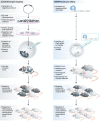Of mice and CRISPR: The post-CRISPR future of the mouse as a model system for the human condition
- PMID: 28119373
- PMCID: PMC5286389
- DOI: 10.15252/embr.201643717
Of mice and CRISPR: The post-CRISPR future of the mouse as a model system for the human condition
Abstract
The mouse has been a major model system for biomedical research. Gene editing technologies will further increase its importance for studying the human condition and human diseases.
Figures

References
-
- Cavanaugh SE, Pippin JJ, Barnard ND (2014) Animal models of Alzheimer disease: historical pitfalls and a path forward. ALTEX 31: 279–302 - PubMed
MeSH terms
Grants and funding
LinkOut - more resources
Full Text Sources
Other Literature Sources
Molecular Biology Databases

